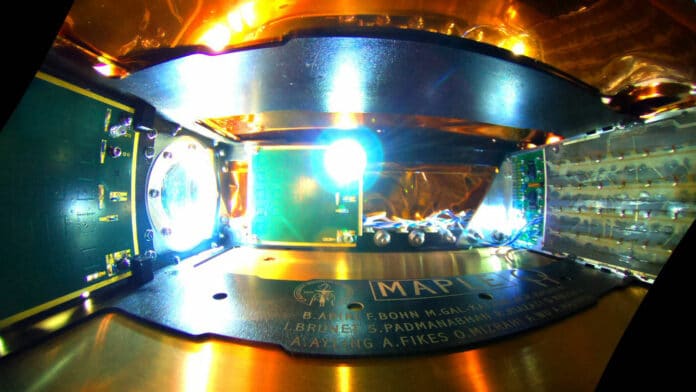Space solar power provides a way to tap into the practically unlimited supply of solar energy in outer space. Solar energy from space is continuously available, not subject to the cycles of day and night, seasons, and cloud cover, which can yield up to eight times more energy than solar panels anywhere on Earth’s surface.
However, storing space solar energy, transmitting it to Earth, and using it is still challenging.
To overcome this problem, researchers at the California Institute of Technology (Caltech) have developed a Microwave Array for the Power-Transfer Low-Orbit Experiment (MAPLE) aimed at generating and transmitting solar energy from space to Earth’s surface.
The space solar power prototype launched into orbit in January is now operational. It has demonstrated its ability to wirelessly transmit power in space and to beam detectable power to Earth for the first time.
Being tested by the Space Solar Power Demonstrator (SSPD-1), it is the first space-borne prototype from Caltech’s Space Solar Power Project (SSPP) that aims to harvest solar power in space and transmit it to the Earth’s surface.
MAPLE consists of flexible, lightweight microwave power transmitters powered by custom electronic chips built using low-cost silicon technology. It uses an array of transmitters to beam the energy to desired locations.
For SSPP to be feasible, energy transmission arrays must be lightweight to minimize the amount of fuel needed to send them into space, flexible enough to be folded into a package that can be carried in a rocket, and overall low-cost technology.
Using constructive and destructive interference between transmitters, a bank of power transmitters can shift the focus and direction of the energy it beams out without any moving parts. A transmitter array uses a precisely timed-control element to dynamically focus power to a desired location using a coherent combination of electromagnetic waves. Due to this, most of the energy is transmitted to the desired place.
To receive the energy, MAPLE features two separate receiver arrays located about a foot away from the transmitter. It then converts the energy to direct current (DC) electricity and uses it to light up a pair of LEDs to show the full sequence of wireless energy transmission at a distance in space. MAPLE tested this by lighting each LED individually in space and moving back and forth between them. The experiment is not sealed, so it is subject to the harsh environment of space, including the wide temperature swings and solar radiation that large-scale SSPP units will face one day.
MAPLE also includes a small window through which the array can transmit the energy. This transmitted energy was then detected by a receiver on the roof of the Gordon and Betty Moore Laboratory of Engineering on Caltech’s campus in Pasadena.
According to the researchers, the received signal appeared at the expected time and frequency and had the right frequency shift as predicted based on its travel from orbit.
Through the experiments researchers have run so far, they received confirmation that MAPLE can transmit power successfully to receivers in space. Researchers have also been able to program the array to direct its energy toward Earth, which they detected at Caltech.
“To the best of our knowledge, no one has ever demonstrated wireless energy transfer in space, even with expensive rigid structures. We are doing it with flexible, lightweight structures and with our own integrated circuits. This is a first,” says Ali Hajimiri, Bren Professor of Electrical Engineering and Medical Engineering and co-director of SSPP.
“In the same way that the internet democratized access to information, we hope that wireless energy transfer democratizes access to energy,” Hajimiri says. “No energy transmission infrastructure will be needed on the ground to receive this power. That means we can send energy to remote regions and areas devastated by war or natural disaster.”
Researchers tested MAPLE on Earth and know the demonstration that the power transmitters also could survive the launch and space flight and still function. In addition, the experiment has provided useful feedback to SSPP engineers. Power transmission antennas are assembled into groups of 16, each group driven by a fully custom flexible integrated circuit chip.
The research team is now evaluating the performance of individual components in the system by evaluating intervention patterns in small groups and measuring differences between different combinations.
The process could take six months to complete and will allow the team to sort out irregularities and trace them back to individual units, providing insights for the next generation of the system.
After thoroughly studying this system, the SSPP will deploy a constellation of modular spacecraft. These spacecraft will collect sunlight, transform it into electricity, then convert it to microwaves that will be transmitted wirelessly over long distances to wherever it is needed, including locations that currently have no access to reliable power.
“In the same way that the internet democratized access to information, we hope that wireless energy transfer democratizes access to energy,” Hajimiri says. “No energy transmission infrastructure will be needed on the ground to receive this power. That means we can send energy to remote regions and areas devastated by war or natural disaster.”
